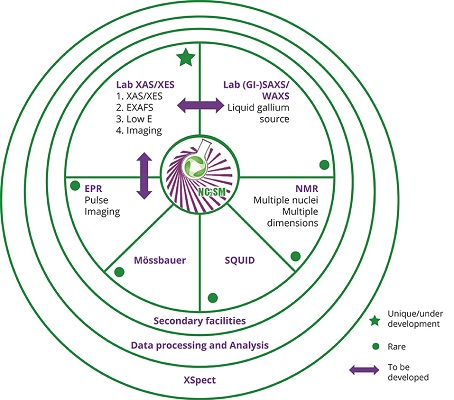Moniek Tromp, Van t Hoff Institute for Molecular Sciences, Sustainable Materials Characterisation sheds light on sustainable materials and their benefits
An integrated expertise characterisation centre providing a full set of advanced characterisation methods, some of which unique to the world, will enable sustainable materials scientists to characterise their materials and processes in all detail; using all eyes and ears to make pictures and movies of molecules and materials in action. This allows the rational design of novel materials and processes, which meet today’s societal challenges, i.e. clean, requiring limited energy and using cheap and abundant resources.

Important ace of sustainability
Sustainability is important to accommodate the growth of the world’s population and its future demand of resources for water, food and energy at a higher average standard of life. This requires a significant change in today’s practice, including the minimisation of the manufacturing footprint of a material, but also the sustainable gains of its use during the life cycle and clever reuse of the material or its components. Integral sustainability must become a driver for new energy technologies, to produce durable systems to convert, produce and store clean energy.
Resources for energy (fossil origin) and raw materials (rare elements) are depleting and this requires a transition to sustainable energy production as well as the reduction, replacement, or recycling of rare elements and the further development of bio-based materials. The transition to a sustainable society will likely have a tremendous impact. While initial efforts are aimed at reducing the footprint by making existing technologies more efficient, the final goal is a (circular) society based on truly sustainable resources for energy and materials. In this transition to a sustainable society, advanced materials will play a crucial role; a sustainable society cannot be realised without the corresponding materials that enable it. These materials will have in common: less non-renewable energy use and less greenhouse gas emission during the synthesis, construction, processing, packaging, transportation usage, recycling, and reuse.
Materials science
Materials Science is the discipline that engages with the design, synthesis, structure, dynamics and performance of materials. It is a multidisciplinary field that includes physics, chemistry, biology, and engineering, and studies materials in a broad range of length scales from the atomic scale, through nano and micro, all the way up to the macro scale. In order to replace scare raw materials, the functionality of materials needs to be understood much better, i.e. at all levels and in all its details. Further development and increased availability of the characterisation toolbox for this is a prerequisite in this domain.
Proper understanding not only means characterisation of the geometrical structure, from atomic to molecule and agglomerate /particle scale, but also the electronic structure. The latter determines, for a large part, the properties and reactivity of materials, but is also typically difficult to pinpoint, requiring a multitude of different and non-standard characterisation techniques. A radically different approach towards materials characterisation is thus required.
Most laboratories active in a specific materials research area specialise and invest in one characterisation technique only, which is most important or best available to them, and have experts in that one technique only. The problem with most techniques is that they only provide partial characterisation of the material under investigation. Combining several measurements of the same sample, under identical conditions, often leads to much more information than just the sum of individual data. Current challenges in sustainable materials, as described above, require detailed characterisation on multiple levels which can only be achieved with multiple techniques, i.e. ‘all the eyes and ears one can have’. Groups or laboratories generally do not have the possibilities (staff, finances and expertise) to offer, develop and/or execute all of these well. In addition to that, important X-ray techniques, allowing characterisation from atomic (Angstroms) up to inter-molecular information (micrometer) are typically performed at synchrotrons, with high oversubscription rates, severely limiting the accessibility. A radically different approach to materials characterisation is therefore crucial to ensure one can meet the materials science challenges we are facing today.
National Characterisation Centre for Sustainable Materials
To unravel the novel chemistry displayed by these feedstocks and materials as well as their differing reactivity requires multiple advanced techniques, in an integrated approach. We are therefore in the process of setting up a National Characterisation Centre for Sustainable Materials (NC2SM) in which we bring important non-standard techniques together in one place, as well as develop novel and combined ones, by making x-ray absorption, emission, and scattering techniques available in the laboratory. Having access to all techniques in one place, thus making it possible to collect all necessary data in an unequivocal manner on the same sample under identical (operando) conditions, is key to fundamental materials understanding and subsequent rational design and development.
The suite of techniques will give detailed structural as well as electronic information on the broad range of materials, at different time and length scales, from all different parts of the material/molecule. All techniques have their individual strengths and limitations, and only a combination of all can provide a full picture and movie of the sample and its reactivity. Moreover, the integrated centre will therefore not just act as a place to obtain data, but also as a sounding board and discussion platform for materials scientists, spectroscopists and theoreticians, which will catalyse novel and exciting science and advances in all fields.
Prof. Dr Moniek Tromp
Professor
University of Amsterdam
Van t Hoff Institute for Molecular Sciences, Sustainable Materials Characterisation
Tel: +31 20 525 6994
Please note: this is a commercial profile











